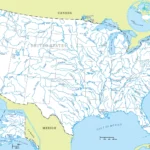South Carolina’s rich tapestry of landscapes, from the sun-kissed Atlantic coast to the rolling Piedmont and the majestic Blue Ridge Mountains, has indelibly shaped its economic and demographic evolution. This article delves into the intricate interplay of geography, history, and population dynamics, exploring how these factors have molded South Carolina’s present and offering insights into its future. For a broader geographical context, check out this 2025 World Map.
The Shaping Hand of Geography
South Carolina’s diverse topography has carved distinct regional identities, each with unique economic and demographic characteristics. The Coastal Plain, stretching westward from the Atlantic, boasts fertile lowlands and expansive beaches. Historically, this region’s agricultural richness, particularly suited to rice and indigo cultivation, fueled a plantation economy that profoundly impacted the state’s social and economic fabric. This legacy continues to resonate today, influencing land ownership patterns and cultural traditions.
The Piedmont, characterized by rolling hills and abundant rivers, emerged as a center of industrial activity. Cities like Columbia, the state capital, and Greenville flourished, drawing populations seeking manufacturing and economic opportunities. The presence of major rivers like the Santee and Savannah not only facilitated transportation and industry but also provided crucial water resources, further contributing to the region’s growth.
The Blue Ridge Mountains, rising majestically in the northwest, offer breathtaking scenery and recreational havens. This region’s natural beauty attracts tourists and fosters a distinct economic niche centered around outdoor activities and tourism-related services. The mountains also provide a unique habitat for diverse flora and fauna, contributing to the state’s overall biodiversity.
Population Dynamics: A Reflection of Geography
South Carolina’s population distribution mirrors its geographic diversity. Coastal areas, particularly around Charleston, a historic port city with a thriving tourism sector, and Myrtle Beach, a popular vacation destination, boast high population densities. These areas attract retirees, vacation home owners, and those seeking employment in the tourism and hospitality industries.
The Piedmont, with its mix of urban centers and rural landscapes, supports a substantial population engaged in a variety of economic activities. Manufacturing, agriculture, and a growing technology sector provide diverse employment opportunities, attracting a mix of skilled workers and families.
The mountainous regions, while less densely populated, offer a unique lifestyle that draws residents seeking a slower pace and access to outdoor recreation. This region’s population tends to be more dispersed, with smaller towns and communities nestled within the valleys and foothills.
Historical Echoes: Shaping the Present
South Carolina’s history is inextricably linked to its demographic and economic trajectory. The legacy of plantation agriculture in the Coastal Plain, the rise of industrialization in the Piedmont, and the transformative impact of the Civil Rights movement have all left indelible marks on the state’s social and economic fabric.
The Civil War and the subsequent Reconstruction era brought significant upheaval, reshaping the state’s political and social landscape. The struggle for civil rights and equality in the 20th century further transformed South Carolina, leading to greater inclusivity and social progress. Understanding this complex history is crucial for comprehending the state’s present and navigating its future.
Economic Diversity: A State of Flux
South Carolina’s economy reflects its geographic and historical diversity. Tourism remains a dominant force in the coastal regions, attracting millions of visitors annually and generating significant revenue. However, the state is also actively diversifying its economy, investing in emerging sectors such as technology, aerospace, and automotive manufacturing.
The Piedmont’s blend of traditional industries and emerging sectors creates a dynamic economic landscape. Manufacturing, while still important, is increasingly complemented by advanced manufacturing and technology-based businesses. This diversification helps to create a more resilient economy and provides a wider range of employment opportunities.
The mountains contribute to the state’s economy through tourism, outdoor recreation, and resource management. Sustainable forestry practices and the preservation of natural resources are becoming increasingly important in this region, ensuring long-term economic and environmental viability.
Challenges and Opportunities: Forging a Sustainable Future
South Carolina faces significant challenges, including coastal erosion exacerbated by climate change, the pressures of rapid urbanization, and the need to provide equitable access to resources and opportunities across all regions. Addressing these challenges requires proactive planning and sustainable development strategies.
However, these challenges also present opportunities. Investing in renewable energy sources, promoting sustainable tourism practices, and fostering economic development in underserved areas can create new pathways to prosperity. By leveraging its strengths and addressing its weaknesses, South Carolina can build a more resilient and sustainable future for all its citizens.
A Path Forward: Strategic Investments and Collaborative Action
To fully unlock its potential, South Carolina must prioritize strategic investments and foster collaboration across all sectors. Investing in infrastructure, education, and workforce development can equip the state’s workforce with the skills needed for the jobs of the future.
Promoting sustainable tourism practices can protect South Carolina’s natural beauty while maximizing the economic benefits of this vital sector. Balancing development with environmental protection is crucial for ensuring long-term sustainability.
Targeted regional economic development strategies can address the specific needs and opportunities of each region, fostering balanced economic growth and creating jobs across the state. Supporting local businesses and entrepreneurs is essential for building a vibrant and diverse economy.
By embracing innovation, investing in its people, and prioritizing sustainable practices, South Carolina can navigate the challenges ahead and forge a brighter future for all its residents. The state’s rich tapestry of geography, history, and culture provides a strong foundation for future growth and prosperity.
- China II Review: Delicious Food & Speedy Service - April 17, 2025
- Understand Virginia’s Flag: History & Debate - April 17, 2025
- Explore Long Island’s Map: Unique Regions & Insights - April 17, 2025
















